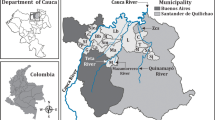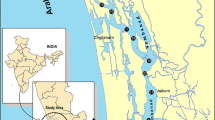Abstract
The abandoned Malachov deposit belongs among the most important historic Hg deposits in the world. The soil, groundwater, surface water, plants, and animals are still heavily contaminated by potentially toxic elements such as As and Cd, but mainly by Hg. This article is focused on the Hg contamination of aquatic plants and animals in the Malachov creek. Mercury concentrations were measured in fresh water (on average 3 µg L−1), in the zoobenthos (on average 362.47 µg kg−1), and in the phytobenthos (on average 578.36 µg kg−1). Higher Hg concentrations were determined in the muscles of Salmo trutta morpha fario (on average 362.47 µg kg−1) and lower in Cottus poecilopus (on average 352.75 µg kg−1). The Hg concentrations were higher in the internal tissues (578.36–1185.75 µg kg−1) than in the muscles of the fish. The Hg content in fresh water exceeded Regulation of the Slovak Government No. 269/2010, which stipulates the criteria for achieving a proper water balance, but the Hg content in the fish muscles of both fish species was below the specified limit of the Food Code of Governmental Regulation of the Slovak Republic No. 608/3/2004–100. The Hg contamination in fishes is controlled by their weight and age. The presented data may be used as the base information for future studies in order to be able to estimate consumption recommendations and warnings.
Similar content being viewed by others
Code availability
The authors confirm that the data supporting the findings of this study are available within the article.
References
Andráš, P., Dirner, V., & Kharbish, S. (2014). Historic deposits and their impact on environment (pp. 15–35). Technická Univerzita v Košiciach.
Bajčan, D., Árvay, J., & Musilová, J. (2013). Evaluation of total mercury content in muscle tissue of marine fish and animals. Journal of Microbiology, 2(1), 1692–1698.
Barber-James, H. M., Gattolliat, J.-L., Sartori, M., & Hubbard, M. D. (2008). Global diversity of mayflies (Ephemeroptera, Insecta) in freshwater. Developments in Hydrobiology, 198, 339–435.
Barbieri, M., Sappa, G., Vitale, S., Parisse, B., & Battistel, M. (2014). Soil control of trace metals concentration in landfill: A case study of the largest landfill in Europe, Malagrotta, Rome. Journal of Geochemical Exploration, 143, 146–154.
Barbieri, M., Sappa, G., & Nigro, A. (2018). Soil pollution: Anthropogenic versus geogenic contributions over large areas of the Lazio region. Journal of Geochemical Exploration, 195, 78–86.
Bárdiová, M. (2019). Malachov. Malachov municipality. 559 p.
Beltran-Pedreros, S., Zuanon, J., Leite, R. G., Peleja, J. R. P., Mendonca, A. B., & Forsberg, B. (2011). Mercury bioaccumulation in fish of commercial importance from different trophic categories in an Amazon floodplain lake. Neotropical Ichthyology, 9, 901–908.
Bjørklund, G., Dadar, M., Mutter, J., & Aaseth, J. (2017). The toxicology of mercury: Current research and emerging trends. Environmental Research Journal, 159, 545–554.
Budtz-Jørgensen, E., Grandjean, P., & Weihe, P. (2007). Separation of risk and benefits of seafood intake. Environmental Health Perspectives, 115(31), 323–326.
Cappon, C. J., & Smith, J. C. (1995). Chemical form and distribution of mercury and selenium in edible seafood. Toxicology Environmental Chemistry, 14, 10–21.
Cerovac, A., Covelli, S., Emili, A., & Pavoni, E. (2017). Mercury in the unconfined aquifer of the Isonzo/Soča River alluvial plain downstream from the Idrija mining area. Chemosphere, 195, 749–761.
Clifton, J. C. (2007). Mercury exposure and public health. Pediatric Clinics of North America, 54(2), 237–269.
Dadová, J., Andráš, P., Kupka, J., Krnáč, J., Andráš, P., Jr., Hroncová, E., & Midula, P. (2016). Mercury contamination from historical mining territory at Malachov Hg-deposit (Central Slovakia). Environmental Science and Pollution Research Journal, 23(3), 2914–2927.
Együdová, I., & Šturdík, E. (2004). Ťažké kovy a pesticídy v potravinách. Nova Biotechnologica, 5, 155–173.
Ferenc, Š, Mikušová, J., & Baláž, P. (2013). Banská Bystrica Geopark—historically important deposits of raw materials. Mineralia Slovaca, 45, 239–244.
Gerstmeier, R., Romig, T. (1998). Die Süßwasserfische Europas. Für Naturfreunde und Angler. Kosmos, Stuttgart, 367 p
Hošek, M., Bednárek, J., Popelka, J., Elznicová, J., Tůmová, Š, Rohovec, J., Navrátil, T., & Matys Grygar, T. (2019). Persistent mercury hot spot in Central Europe and Skalka Dam reservoir as a long-term mercury trap. Environmental Geochemistry and Health, 42, 1273–1290.
Janiga, M., Jr. (2018). Cottus poecilopus Heckel, 1836, in the river Javorinka, the Tatra mountains, Slovakia. Ecologia Montana, 27, 21–26.
Jeleň, S., & Galvánek, J. (2015). Historic sites of copper and mercury mining near Banská Bystrica. Geografická Revue, 11(2), 25–53.
Kafka, Z., & Punčochářová, J. (2002). Heavy metals in nature and their toxicity. Chemické Listy, 96, 611–617.
Kimáková, T., & Bernasovská, K. (2005). Contamination of environment by mercury at industrially influenced areas of Slovakia. Slovenský Veterinársky Časopis, 30(6), 369–370.
Kimáková, T., & Bernasovská, K. (2007a). Ku konzumácii rýb. Hygiena, 52(3), 77–79.
Kimáková, T., & Bernasovská, K. (2007b). The mercury concentration in particular parts of Taraxacum Officinale (Dandelion) in different areas of Slovakia. Planta Medica, 73(9), 268.
Knésl, J., & Linkešová, M. (1971). Preliminary results of the Hg-ores prospecting in Kremnica Mts. Geologický Průzkum, 13(5), 135–137.
Koděra, M., Andrusovová-Vlčeková, G., Belešová, O., Briatková, D., Dávidová, Š., Fejdiová, V., Hurai, V., Chovan, M., Nelišerová, E., Ženiš, P., Fejdi, P., Gregorová, Z., Greguš, J., Határ, J., Hvožďara, P., Chovanová, M., Judinová, V., Karolusová, E., Ondrušová, S., Šamajová, E., Varčeková, A. (1990). Topographic Mineralogy I. 2, 518 p.
Kuwabara, J. S., Arai, Y., Topping, B. R., Pickering, I. J., & George, G. N. (2007). Mercury speciation in piscivorous fish from mining-impacted reservoirs. Environmental Science and Technology, 41(8), 2745–2749.
Langford, N. J., & Ferner, R. E. (1999). Toxicity of mercury. Journal of Human Hypertension, 13, 651–656.
Luczyńska, J., Luczyński, M. J., & Paszczyk, B. (2016). Assessment of mercury in muscles, liver and gills of marine and freshwater fish. Journal of Elementology, 21(1), 113–129.
Maršálek, P., Svobodová, Z., Randák, T., & Švehla, J. (2005). Total mercury and methylmercury contamination of fish from the Skalka reservoir: A case study. Acta Veterinaria Brnensis, 74(3), 427–434.
Midula, P., Turisová, I., & Andráš, P. (2017). Mercury contamination in top soil and plants in area of Veľká Studňa Hg-deposit at Malachov (Central Slovakia). Veda Mladých 2017–—Science of Youth, 2017, 71–77.
Navarro, A. (2008). Review of characteristics of mercury speciation and mobility from areas of mercury mining in semi-arid environments. Reviews of Environmental Science and Bio/Technology, 7, 287–306.
Pereira, L. R., Cabette, H. S. R., & Juen, L. (2012). Trichoptera as bioindicators of habitat integrity in the Pindaiba river basin, Mateo Grosso (Central Brazil). International Journal of Limnology, 48, 295–302.
Randall, P. (2004). Influence of pH and oxidation-reduction potential (Eh) on the dissolution of mercury-containing mine wastes from the Sulfur Bank mercury mine. SME Journal Minerals and metallurgical processing Journal, 21, 1–7.
Sackett, D. K., Cope, W. G., Rice, J. A., & Aday, D. D. (2013). The influence of fish length on tissue mercury dynamics: Implications for natural resource management and human health risk. International Journal of Environmental Research and Public Health, 10(2), 638–659.
Sunderland, E. M. (2007). Mercury exposure from domestic and imported estuarine and marine fish in the U. S. seafood market. Environmental Health Perspectives, 115, 235–242.
Toman, R., Massányi, P., & Ducsay, L. (2001). Mercury in food-chain. Trendy v Potravinárstve, 8(4), 3–4.
Vulterin, J., & Vasileská, M. (1996). Toxic substances, hygiene and security in chemistry (p. 128). Karolinum.
Zmetáková, Z., Šalgovičová, D. (2006). Mercury in chosen parts of environment and food stuffs in the retail network in Slovakia. In Industrial toxicology 06. Bratislava, 169–178.
Funding
This research was funded by grant scheme No. 1/0291/19 of the Grant Agency VEGA (Vedecká Grantová Agentúra MŠVVaŠ SR a SAV).
Author information
Authors and Affiliations
Contributions
PA—composed the main chapters of the manuscript and supervised the whole research, JD—performed the detailed research of mining activity in Malachov, RR, DB—performed the sampling and analytical works, PM, VD—performed statistical evaluation, contributed with several paragraphs in chapters Results and Discussion, prepared the formal shape of the manuscript.
Corresponding author
Ethics declarations
Conflict of interest
The authors declare that there is no conflict of interests.
Availability of data and material
The authors confirm that the data supporting the findings of this study are available within the article.
Ethical approval
All procedures performed in this study involving living animals were in accordance with ethical standards and were supervised by Slovak Fishermen’s Association.
Additional information
Publisher's Note
Springer Nature remains neutral with regard to jurisdictional claims in published maps and institutional affiliations.
Rights and permissions
About this article
Cite this article
Andráš, P., Dadová, J., Romančík, R. et al. Mercury in fish tissues in the area of Malachov Hg-ore deposit (Slovakia). Environ Geochem Health 43, 3675–3681 (2021). https://doi.org/10.1007/s10653-021-00861-x
Received:
Accepted:
Published:
Issue Date:
DOI: https://doi.org/10.1007/s10653-021-00861-x




